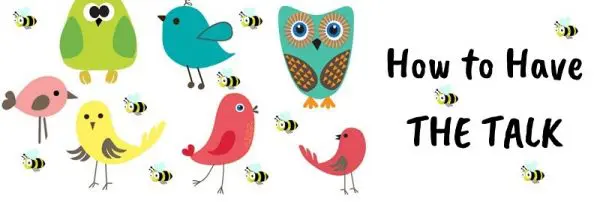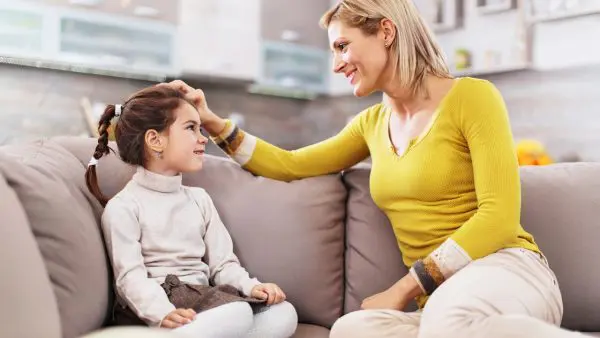I think one of the most nerve-wracking, fear-inducing worries of parenting is THE TALK. You know—the birds and the bees? It seems like no matter how old our kids are, we’re faced with contemplating THE TALK because sex. is. everywhere. in our society. But I have some super-amazing news for you: you don’t need to have THE TALK. In fact, you shouldn’t have THE TALK.
Wait. What? Did I, a sexuality educator, just tell you not to have THE TALK with your kids?! Indeed I did. Because there should never be just one talk. The best way to help your kids learn about sexuality is to have many talks, to explore teachable moments, and to weave information about human sexuality into children’s everyday lives. Starting when? From birth on, folks. From birth on. Believe me when I tell you that there advantages to starting early. (Not the least of which is avoiding that huge, godawful, embarrassing TALK.)

Let’s clear up some terminology real quick, though, okay? When we hear “sexuality” or “human sexuality,” a lot of us focus on just one part: sexual health and reproduction. That’s the anatomy and physiology part. Sexuality is so much more than that, though! It includes things like relationships with other people (including family and friends as well as romantic relationships), things that we enjoy with our senses (like smells, sights, sounds, tastes, and touches), gender identity, gender expression, sexual orientation, and the concept of sexualization (generally unhealthy uses of sexuality to control or manipulate other people). That’s a lot of stuff, right? And in case you’re not already feeling totally overwhelmed, strong sexuality education programs usually consider the parent—that’s you!—to be the primary sexuality educator of their children. Oh my.
So, if you’re in charge of your kid’s sexuality education, and you’re not supposed to have THE TALK, well…what do you do? You provide your child with developmentally appropriate information in an age-appropriate way. Here are some general guidelines for what kids should know when.
Birth to Two Years:
- Teach kids about body parts. Use proper names, including the proper names for their genitals. Doing so puts genitals on even footing with all other body parts; they’re not something to be ashamed of, so embarrassing that we can’t even call them by name. Remember what Dumbledore says, “Always use the proper name for things. Fear of a name increases fear of the thing itself.” Plus, knowing the proper names for genitals is a tool to help prevent abuse. (Pro-tip: external female genitals are called the vulva; the vagina connects the uterus to the vulva.)
- Let kids know that it’s okay to touch all their body parts. (It’s okay to also help children understand that some of that touching should be done in a private place like a bathroom or bedroom.)
- Teach kids about what their body parts do. Teach them that urine (pee) comes out of their urethra, and feces/stool (poop) comes out of their anus.
Two to Five Years:
- Teach kids about the differences and similarities between male and female bodies. Also teach them that all bodies are different and unique and all bodies are wonderful the way they are.
- Help children understand that their body is their own. They are the boss of it, and they don’t have to kiss or hug anyone they don’t want to.
- It can be hard for us as parents, but start talking to you child about touching that is okay and touching that is not okay.
- Help children learn about privacy, including respecting other people’s privacy.
- Introduce the basics about human reproduction: A man (or sperm) and a woman (or egg) come together to make a baby that grows inside a uterus.
- Tell kids that touching our bodies can feel good.

Five to Eight Years:
- Time to go into more detail about external anatomy (clitoris, labia, scrotum, etc.) if you haven’t done that already. Start talking about internal anatomy (uterus, ovaries, bladder, bowels, etc.).
- Now is good time to talk about sexual orientation, such as bisexual, gay, lesbian, and straight.
- You should start talking about puberty with kids as they get to the older end of this age range. This helps them know what they can expect as their bodies continue growing and changing.
- Expand on the basics of human reproduction to include the role that sexual intercourse plays in many conceptions.
- Children should practice refusal skills and learn to clearly state “No” when they are being touched in a way that they don’t like. They should also learn to leave the situation as soon as/if it is possible, and they should tell a trusted adult right away.
Nine to Twelve Years:
- This is the time to start talking about safer sex and contraception.
- You should get into more detail about puberty. Doing this at the younger end of this age range is important, because younger children are more likely to approach the topic with curiosity rather than embarrassment
- Talk about the qualities that make a relationship healthy, and talk about what an unhealthy relationship looks like, too. (This includes friendships, as well as romantic relationships—because, really, we should be looking for similar qualities in both!)
- Help your child become a critical consumer of media, who can judge depictions of sexuality in media (online, print, and television; programming and advertising) as positive or negative and discuss whether they’re realistic.
- Talk about your family’s values as they relate to various issues of human sexuality: relationships, LGBT issues, what sexual behavior you consider appropriate and under what circumstances, consent, dating, etc. One way to do this is by keeping an eye out for teachable moments.

Thirteen to Eighteen Years:
- Provide more information regarding contraception and sexually transmitted infections/diseases (STI/Ds).
- Talk about the consequences (positive and negative) of various sexual behaviors.
- Talk about consent, enthusiastic consent, and how to say no.
- Even if you think you’re out of things to teach your teen, know that if you’ve consistently made human sexuality part of the conversations you’ve had with your child, they’re likely to come to you when they’re seeking information or support.
There’s a lot here, right? But please try not to be too intimidated. There are so many resources to help you talk to your kids about sexuality at all ages. I’m going to list some online resources here (and please know that some of these are directed at kids, but they’re useful for adults, too because they help us understand what age-appropriate information is):
- AMAZE
- Scarleteen
- Advocates for Youth’s Parents’ Sex Ed Center
- Planned Parenthood
I also recommend keeping a selection of books around the house. Pick up some parent-oriented books to help give you language you can use to provide age-appropriate answers to questions. Books by Debra Haffner and Deborah Roffman are great options. Also, keep age-appropriate books for you kids around, too! This can help provide a basis for conversation and is a way for your child to get accurate information about something if they don’t want to talk to you about it. Some of my favorite authors for younger kids (ages 4ish through 12ish) are Robie Harris and Cory Silverberg.
Don’t be overwhelmed by all this! Enjoy the chance to talk your children and help them learn about bodies, relationships, and your family’s values. And please remember that your silence about human sexuality will communicate just as much to your child as your conversations will. The question is: what messages do you want to communicate? The ones your child infers based on the fact that sex is a taboo topic, or the ones you communicate by information-sharing and open, honest discussion? Think about it.
